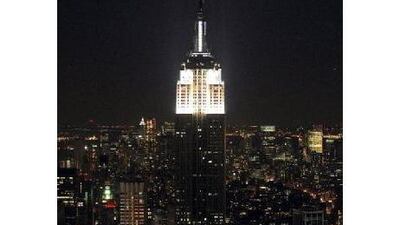It is estimated that about 30 per cent of all energy used in commercial buildings is wasted, partly as a result of the materials used in construction. The buildings materials industry is not one that immediately springs to mind when we think about innovation. It may be because the brightest and best brains of the past few generations have been applying their intellect in the worlds of finance and technology. Yet the construction industry is important - the built environment in which we work and live is responsible for 50 per cent of greenhouse gas emissions worldwide.
One company that is applying new "disruptive technology" to the construction materials industry to reduce emissions is Serious Materials, based in Sunnyvale, California. It is re-engineering common building products that use or lose the most energy. The company is upgrading all 6,500 dual-pane windows in the Empire State Building in New York by reusing the existing glass to create a more efficient material. The process is expected to result in a 38 per cent reduction in energy use and will pay for itself within three years.
This innovative approach to problem solving seemed sorely lacking at last week's Cityscape Global construction sector exhibition held in Dubai. Trying to have an up-beat discussion with the sales representatives on the stands was, for me, analogous to attending a wake for the commercial property sector. There is a tremendous glut of vacant commercial property on the market today in Dubai, with plenty more to come. The question is, what can be done about it?
I've heard a number of options. One radical solution doing the rounds is to knock down all of the empty, unwanted or incomplete commercial towers. This way the supply can be tightly controlled. Any developers or investors stuck in such a projectcould be given compensation by the master developer. Or, more realistically, they could move to a mature commercial area. There have also been comments about the establishment of a central planning body to co-ordinate the work of the 16 free zones within Dubai. This body would have strategic oversight of all commercial property and be afforded the choice to make executive decisions that benefit the city overall.
To me, these and other ideas all deserve to be heard by the respective decision makers. However, they are not the kind of decisionscivic leaders can make over night. They need to assess, ponder, consult and reflect, before deciding and that means we might be at Cityscape Global next year by the time any decisions are made. Policymakers are also conscious of the heavily reduced tenanting cost of commercial office space, which means Dubai is once more financially attractive for organisations looking to set up in the Middle East or deciding where to base their staff. Coupled with the fall in residential prices, the city has been reclaimed as a mid-market proposition, which is a positive development since the mass of the market is always to be found in the middle.
Landlords bemoaning their bad luck at having built or invested in commercial office space only to find it untenanted, can also do their part to make Dubai a more attractive proposition. The convention over the past decade has been to hand over commercial office space as "shell and core" to the prospective tenant. This means the building would have its core structure, a vertical transport system (lifts, escalators) as well as the shell - the facade of the building.
However, the "in-fills", such as floors, ceilings, finishes and interior decoration are not provided to the commercial tenant. In the 1990s landlords in the UAE would generally rent out finished commercial office buildings, with all in-fills completed. The change came about because of the need to accommodate ICT (information communications technology) infrastructure such as cable trays, patch panels, switches and the like. But today, much of this ICT infrastructure is either wireless or standardised and unless the tenant is setting up something akin to a dealing floor of a stock exchange, their requirements can be fulfilled with a more generic infrastructure.
So, if landlords reestablish the previous convention of providing their tenants with a finished commercial office space as opposed to shell and core it may encourage more companies to occupy such space. Remember, the cost of fitting out commercial office space can be more than a couple of years of rent on the property itself, so if it's already been done for the tenant then it makes the property exceptionally attractive.
A business acquaintance of mine was recently won over by a landlord who made just this proposal. The businessman is moving out of his old office space in a more cramped part of town to a new, fully in-filled commercial space in a mixed-use area. Whether other landlords decide to be so innovative and follow suit, is a matter for them. But even a little innovation that spurs the market is better than none.
Rehan Khan is a business consultant and writer based in Dubai

